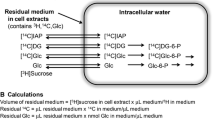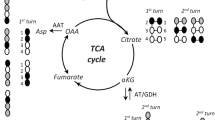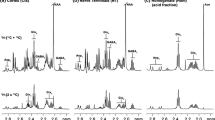Abstract
We studied the uptake of [3H]2-deoxyglucose ([3H]2DG) by slices of rat cerebral cortex in vitro as a model of glucose transport by brain. Slices were incubated with [3H]2DG, or withl-[3H]glucose as a marker for diffusion; the difference between [3H]2DG uptake andl-[3H]glucose uptake was defined as net [3H]2DG transport. Net [3H]2DG transport was a function of incubation temperature, with an estimated temperature coefficient of 1.87 from 15°C to 25°C. The net uptake of [3H]2DG was not inhibited by phlorizin or phloretin in concentrations well above the reported Ki of these inhibitors for hexose uptake in other systems. To examine the hypothesis that [3H]2DG transport by brain slices is dependent on mitochondrial energy, we studied net [3H]2DG uptake by slices which had been preincubated in media designed to alter intracellular ATP stores. The transport process was very sensitive to inhibition by DNP, but the correlation between [3H]2DG transport and ATP levels was unclear. In contrast to our published hypothesis that the transport process required mitochondrial energy, these data indicate that dependence on energy is not absolute.
Similar content being viewed by others
References
Scheinberg, P. (1975). Cerebral blood flow, Pages 147–156,in Tower, D. B., andChase, T. N. (eds.), The Nervous System, The Clinical Neurosciences. Vol. 2, Raven Press, New York.
Bachelard, H. S. (1976). Carbohydrate and energy metabolism of the central nervous system: Biochemical approach, Pages 1–26,in Vinken, P. J., Bruyn, G. W., andKlawans, H. L. (eds.), Metabolic and Deficiency Diseases of the Nervous System Part I, Handbook of Clinical Neurology, Vol. 27, American Elsevier, New York.
Diamond, I., andFishman, R. A. 1973. High-affinity transport and phosphorylation of 2-deoxy-d-glucose in synaptosomes. J. Neurochem. 20:1533–1542.
Fletcher, A. M., andBachelard, H. S. (1978). Demonstration of high affinity hexose uptake in cerebral cortex slices. J. Neurochem. 31:233–236.
Heaton, G. M., andBachelard, H. S. (1973). The kinetic properties of hexose transport into synaptosomes from guinea pig cerebral cortex. J. Neurochem. 21:1099–1108.
Wheeler, D. D., andHollingsworth, R. G. (1979). Uptake of 2-deoxy-d-glucose by cortical synaptosomes from the Long-Evans rat. J. Neurosci. Res. 4:133–145.
Gold, B. I., andKyle, J. T. (1981). [3H]2-Deoxyglucose transport by slices of cerebral cortex: Apparent dependence upon mitochondrial energy. Neurochem. Res. 6:949–958.
Gold, B. I., Simon, J. R., andRoth, R. H. (1978). Glutamic acid decarboxylase activity in striatal slices: Persistent increase following depolarization. Life Sci. 22:187–194.
Cooney, D. A., Jayaram, H. N., Homan, E. R., andMotley, C. F. (1974). A facile radiometric technique for measuring ATP. Anal. Biochem. 62:157–165.
Bradford, M. M. (1976). A rapid and sensitive method for the quantitation of microgram quantities of protein utilizing the principle of protein-dye binding. Anal. Biochem. 72:248–254.
Zivin, J. A., andBartko, J. J. (1976). Statistics for disinterested scientists. Life Sci. 18:15–26.
Stein, W. D. (1967). The Movement of Molecules Across Cell Membranes. Academic Press, New York, p. 71.
Cohen, S. R. (1973). The rate equation and activation energies for the uptake of α-aminoisobutyric acid by mouse brain slices. J. Physiol. 228:105–113.
Christensen, H. N. 1975. Biological transport. W. A. Benjamin, Inc., Reading, Massachusetts, p. 111.
LeFevre, P. G., andMarshall, J. K. (1959). The attachment of phloretin and analogues to human erythrocytes in connection with inhibition of sugar transport. J. Biol. Chem. 234:3022–3026.
Alvarado, F., andCrane, R. K. (1962). Phlorizin as a competitive inhibitor of the active transport of sugars by hamster small intestine, in vitro. Biochim. Biophys. Acta. 56:170–172.
Author information
Authors and Affiliations
Rights and permissions
About this article
Cite this article
Kyle-Lillegard, J., Gold, B.I. Hexose transport by brain slices: Further studies on energy dependence. Neurochem Res 8, 473–481 (1983). https://doi.org/10.1007/BF00965103
Accepted:
Issue Date:
DOI: https://doi.org/10.1007/BF00965103




